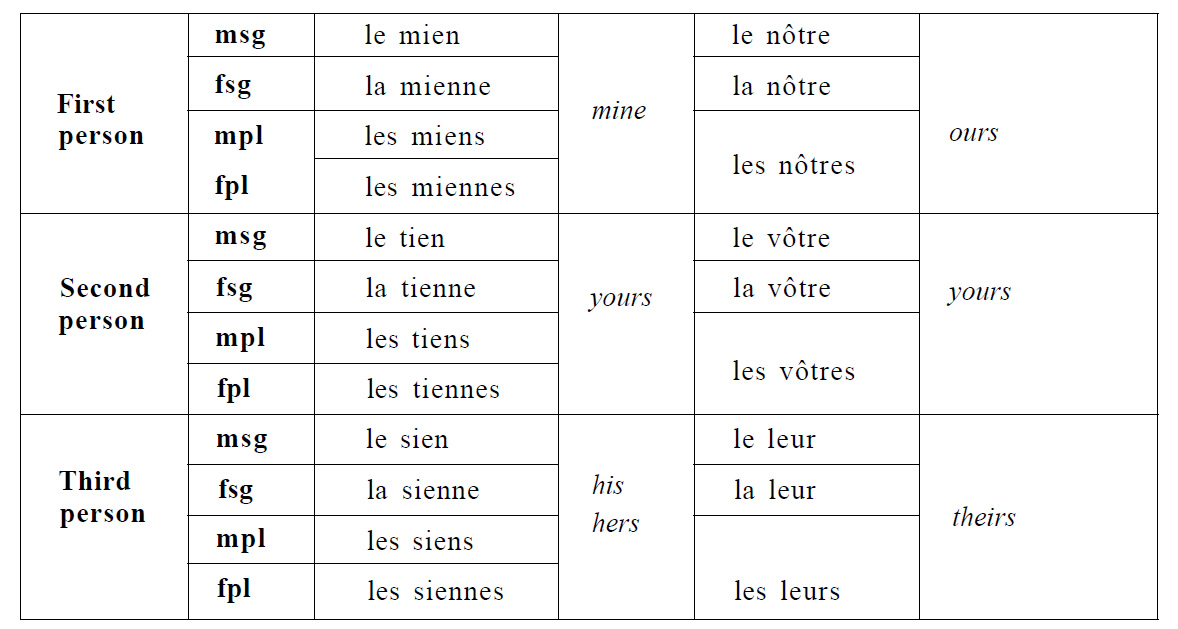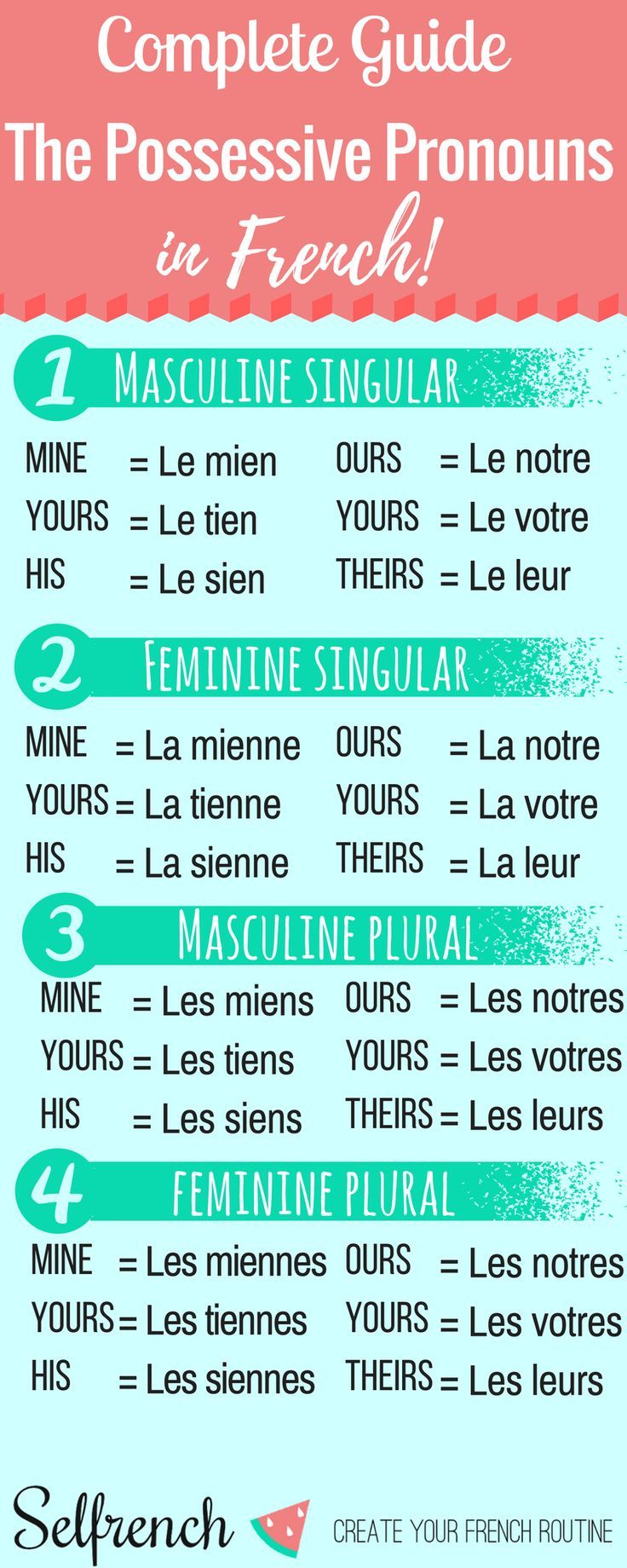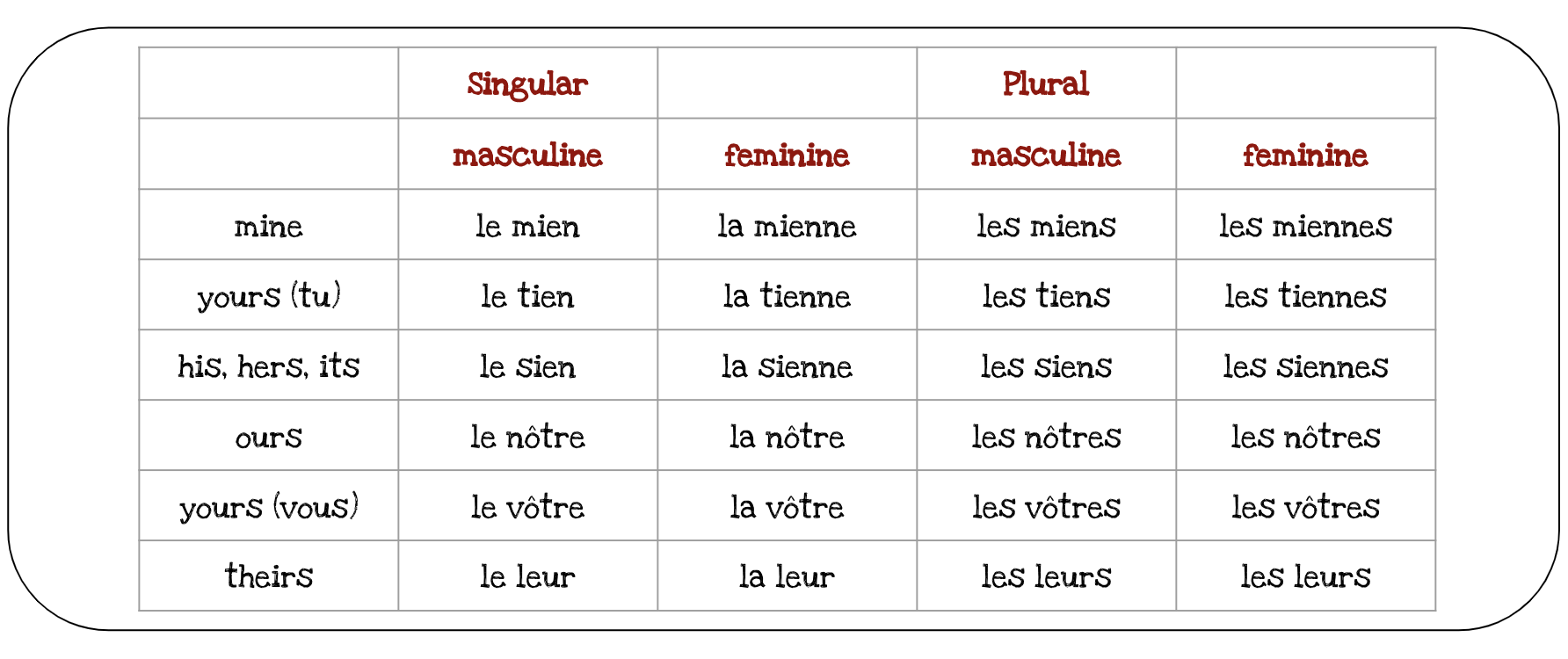
Possessive Pronouns Mini French Lesson Love Learning Languages
In French, possessive pronouns are used instead of a noun to show that one person or thing belongs to another, for example, Ask Carole if this pen is hers. Here are the French possessive pronouns: Ces CD-là, ce sont les miens . Those CDs are mine. Heureusement que tu as tes clés. J'ai oublié les miennes . It's lucky you've got your keys.

French possessive pronouns All you need to know
French has 21 possessive pronouns In French, there are different forms of possessive adjectives for each grammatical person depending on whether the possessed noun is masculine or feminine, singular or plural. Note that the singular pronouns have four forms: Masculine singular: le mien, le tien, le sien

French Possessive pronouns/adjectives C'est le mien ! Teaching Resources
French Possessive Adjectives and Pronouns Ready to tell your story? You'll need the help of possessive adjectives to do so! An adjective is anything that modifies (or changes the meaning of) a noun. The most typical examples are descriptions that express opinions (beautiful, handsome, etc.), colors, shapes, or sizes.

Possessive Adjectives French Exercises With Answers Entrepontos
Direct object pronouns are used when the verb is directly acting on the object, while indirect object pronouns are used when the verb is acting on the object indirectly. The object pronouns in French are: Direct Object Pronouns: me (me) te (you - singular) le (him/it - masculine) / la (her/it - feminine) nous (us)

French Grammar Possessive pronouns
Pronouns replace a noun, while determiners describe a noun. Determiners come before the noun in a sentence, and can be possessive, demonstrative, indefinite and interrogative. Read this page for an overview of French determiners and pronouns, then click on the topics for free and interactive exercises.
Level B1 French Possessive Pronouns Love Learning Languages French
French possessive pronouns work the same way, with a couple of differences: The pronoun must match the gender and number (singular or plural) of the noun it replaces. A definite article - le, la or les - comes before the pronoun. Here is a summary of all the possessive pronouns in French: Singular Plural; Masculine Feminine

French Possessive pronouns all three parts (only £5!!) Teaching Resources
C'est la sienne. It is the watch of Jean. It's his. Jean is a man, but the watch ( la montre) is feminine. Because la montre is feminine, you have to use a feminine possessive pronoun. In this case la montre is singular, so we have to use la sienne. We have handled two examples where the gender was relevant.

Possessive Pronouns in french Possessive pronoun, Vocab, Possessives
Possessive pronouns and determiners (les déterminants et pronoms possessifs) indicate possession or belonging. They agree in gender and number with the noun that they describe (determiners) or replace (pronouns).

French Possessive Pronouns Explanation and Exercises JoliFrench
Logically named possessive pronouns are pronouns that indicate possession. Rex est le chien de Barbara ; il est le sien. - Rex is Barbara's dog ; he's hers. Barbara is a noun and le sien replaces her name with the possessive pronoun 'hers'. French possessive pronouns have different forms to agree with the gender and number of the thing.

Educational infographic The Possessive Pronouns in French Les pronoms possessif en français
French pronouns Pronouns in French are crucial components of conversation, both written and spoken, and are used to replace nouns and distinguish between subject, object, and possessive forms. In French, pronouns must agree with the verb in both number (singular or plural) and gender (masculine or feminine).

French Possessive Pronouns YouTube
In French, possessive pronouns are divided into two categories: strong and weak. 1. Strong Possessive Pronouns: These are used to replace a noun + the definite article (e.g. "my book" can be replaced by "le mien"). The strong possessive pronoun changes depending on the gender and number of the noun it replaces.

How To Use Possessive Pronouns In French Language Atlas
A possessive pronoun is a word or words that replace (s) a possessive adjective and the thing that is owned. For instance, in English, "his house" could be replaced with "his" in a sentence like: "It's his." In French, the possessive pronoun is paired with an article or in some cases a preposition.

French possessive pronouns PDF Possessive pronoun, Possessives, Education
8. French possessive pronouns (pronoms possessifs) Possessive pronouns work very similarly to possessive pronouns in English. You're surely familiar with the English ones already: mine, his, hers, ours, etc. There are a few important differences between how French and English possessive pronouns are used. The first is - you guessed it.

French Possessive Pronouns Love Learning Languages
A possessive pronoun dictates the possession of a noun without that noun being explicitly expressed in the sentence. In French, possessive pronouns translate to mine, yours, his/hers/its, ours, yours, or theirs. Take a Look at the following examples in English. Yes, these keys are mine. Stop looking for your wallet - I have yours!

French Possessive pronouns Masculine and feminine only £4! Teaching Resources
Les pronoms possessifs en Français Salut, and welcome to our lesson about French possessive pronouns at Language Easy! Allez, on y va ! What are the French possessive pronouns ? Qu'est-ce que les pronoms possessifs ? Possessive pronouns (les pronoms possessifs) replace nouns that are preceded by a possessive adjective.

LEARN FRENCH MASCULINE POSSESSIVE PRONOUNS How To Say MINE, YOURS, HIS, HERS) YouTube
In French, possessive pronouns vary in form depending on the gender and number of the noun they replace. The gender and number of the possessive pronoun must agree with the gender and number of the noun possessed, not that of the possessor. Gender and Number Agreement: the Owner is Irrelevant